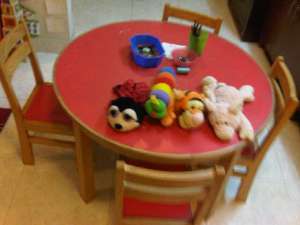In many ways, the Pehli Kiran School System can be seen as a microcosm of the education sector in Pakistan. The standard issues plaguing the sector will make for a rant for another day. For now, I just want to dip into my initial thoughts about each of the schools – to draw them out and preserve them here, before they are erased by routine.
PK8: The Model School
This is the one that’s easiest to find, just at the end of Margalla Road. Consequently, it is the one that is most frequented by visitors – a kind Friend of the Trust even sends lunch every Friday. Brightly painted cloths are strung between the poles, posters with “sky”, “grass”, and “root” letters.I have a good feeling about this.
The children are confident and sociable. It seems to be a melting pot of cultures, where representatives from both Afghan and Punjabi families seem to be co-existing quite happily. Bushra, the young Math teacher, is leading a game called “cat and mouse”, where tiny prospective cats and mice are squirming, jumping, begging to be picked. There are girls in the older classes and if they are shy, they are not unfriendly.
PK4: DifferentThere is a dust path forking into a different direction from PK8. The van bravely goes as far as it can, then stops. I have to say, I’m a little nervous while following Munawwar Sahib on a fairly steep climb. It would be very embarrassing to slip.
Suddenly, the school comes into view and that’s when something in me begins to sink. The sheds are purely bamboo and the canvas roof is not particularly well-kept, but that isn’t what feels wrong. There are far fewer children here, and they don’t sit on their mats in organized formations, or make concentric circles with their shoes. They stand up to greet me, but very few smile. Out of the few who are wearing uniforms, one little boy’s blue shirt only has a single collar button. The ends stream behind him as he runs between the classes, teasing the older ones.
Munawar Sahib proceeds with his briefing. The children are divided along ethnic and linguistic lines – the Pushto-speakers don’t mix well with the Farsi-speakers, the Shyaari speakers have an identity of their own. Most of the families are either from the tribal agencies, or from Afghanistan. The Punjabis are generally hesitant about sending their kids here. The reason for the low attendance on this particular day is that the fathers have taken their children for “chaanti”, to find things to sell in the weekly market stalls. Mothers stay at home, and there are no girls in Class 5.PK3: The Green One
I find serenity in PK3. Overlooking fields of green, the school itself is surrounded by an orderly plantation. The structure looks strong and comfortable – an accepted part of the environment.
Walking through the settlement, I feel a little like an intruder – women are lying on charpoys in the open, enjoying their afternoon siesta. However, the community doesn’t seem to mind. People wave at Munawwar Sahib and an elderly, bearded gentleman comes forward to shake his hand. Later, I learn that he is the head of the Parent Teacher Association and has helped gather support to build a toilet for the teachers.
This is a full school, with nearly as many girls as boys. Perhaps it is because most of the families are from a less conservative culture; perhaps it is because most of the working mothers want their children to be more than their good-for-nothing fathers. Perhaps it is because the school serves as a day-care centre while the females go off to work as domestic labour, leaving multiple children to be watched by the teachers.
“Buy one, get two free!” laughs one, gesturing towards the toddlers who are far too young for nursery.
One of them peeks at me from behind his sister. For the first day, I’m glad we end things here.





Pingback: “hamaray hamaray hamaray school” | the write thing·
PK 7 is also great…
Loved the response of the kids and the experience cleared many misconceptions about that part of society…
PK7 IS great! Needs a little bit of attention in some ways, but there are some particularly bright kids there.
Pingback: to be and to sing | the write thing·
Pingback: bright yellow bag, deconstructed | the write thing·
Pingback: goodbye PK-6 | the write thing·
Pingback: the journey to “real” | the write thing·